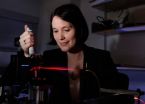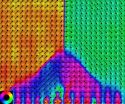(Press-News.org) The researchers are from the National Institutes of Health, collaborating with labs at The Scripps Research Institute and the University of California, San Diego. The finding is published in the March 10 edition of Science Express.
"This is an important step forward — it was impossible until recently to know how this type of receptor is switched on by chemical signals like a tiny machine," said Dr. Kenneth A. Jacobson, chief of the Laboratory of Bioorganic Chemistry in NIH's National Institute of Diabetes and Digestive and Kidney Diseases (NIDDK) and an author on the paper. "The architecture of the activated receptor allows us to think in more detailed terms about the other half of the drug interaction. We hope that we're on the verge of a revolution that will expedite the process of crafting new drugs to treat disease."
With this finding, scientists in Jacobson's lab, including co-author Dr. Zhan-Guo Gao, will next work on testing this drug-engineering approach with similar molecules they have newly synthesized.
Jacobson and Gao are part of the NIDDK's intramural program, which enables basic scientists and clinicians of diverse skills and expertise to collaborate on solutions to some of the most difficult issues of human health. Several compounds from Jacobson's lab are currently in clinical trials as potential treatments for conditions including chronic hepatitis C, psoriasis and rheumatoid arthritis.
"Discoveries like this, with the potential to lead to future treatments in a wide variety of areas, are why NIH funds basic science," said NIDDK Director Dr. Griffin P. Rodgers. "By understanding the body at its smallest components, we can learn how to improve whole-body health."
A receptor is a protein that receives and sends signals to other molecules. The three-dimensional structure of the solved receptor also contains an agonist — a chemical command signal from outside the cell — in this case, an adenosine molecule. Similar to the function of a telephone receiver, the receptor acts as a sensor, picking up the message from the agonist and transmitting its information, which begins processes inside the cell.
The researchers discovered that a previously known agonist molecule would bind to its receptor target in a way that stabilizes the protein for crystallization. Once crystallized, the structure can be seen by bombarding it with X-rays. The agonist solidifies the protein by connecting to multiple parts of the receptor with its molecular arms, in the process initiating the function of the entire structure. This adenosine receptor, called A2A, counteracts inflammation and responds to organs in distress. It belongs to the G-protein coupled receptor family, which is involved in processes necessary for many drugs currently in use to take effect. These findings may lead to new drugs for many diseases.
The research was also supported by the National Cancer Institute and the National Institute of General Medical Sciences, both components of the NIH.
"Long-term NIH technology investments in structural biology, including the Protein Structure Initiative, have brought diverse teams of investigators together and yielded powerful methods like the ones used in this study," said NIGMS Director Dr. Jeremy M. Berg. "Receptors must undergo substantial changes in shape in order to function, and revealing these molecular dances in such great detail is an impressive accomplishment."
INFORMATION:
The NIDDK, a component of the National Institutes of Health (NIH), conducts and supports research on diabetes and other endocrine and metabolic diseases; digestive diseases, nutrition and obesity; and kidney, urologic and hematologic diseases. Spanning the full spectrum of medicine and afflicting people of all ages and ethnic groups, these diseases encompass some of the most common, severe and disabling conditions affecting Americans. For more information about the NIDDK and its programs, see www.niddk.nih.gov.
The National Institutes of Health (NIH) — The Nation's Medical Research Agency — includes 27 Institutes and Centers and is a component of the U.S. Department of Health and Human Services. It is the primary federal agency for conducting and supporting basic, clinical and translational medical research, and it investigates the causes, treatments, and cures for both common and rare diseases. For more information about NIH and its programs, visit www.nih.gov.
Finding of long-sought drug target structure may expedite drug discovery
NIH researchers and collaborators explore receptor at the atomic level
2011-03-16
ELSE PRESS RELEASES FROM THIS DATE:
Corporate Colocation Inc. Completes Examination in Conformity with Statement on Auditing Standards No. 70 (SAS 70), Service Organizations
2011-03-16
The exhaustive audit covered the period September 1, 2010 through February 28, 2011 and was performed by an independent accounting and auditing firm.
Completion of the SAS 70 Type II examination indicates that Corporate Colocation Inc. processes, procedures and controls have been formally evaluated and tested by an independent accounting and auditing firm. The examination included the company's controls related to: Physical Security, Environmental Security and Network Monitoring.
SAS 70 is designated by the U.S. Securities and Exchange Commission (SEC) as an acceptable ...
New laser technique opens doors for drug discovery
2011-03-16
A new laser technique has demonstrated that it can measure the interactions between proteins tangled in a cell's membrane and a variety of other biological molecules. These extremely difficult measurements can aid the process of drug discovery.
Scientists estimate that about 30 percent of the 7,000 proteins in a human cell reside in the cell's membrane and that these membrane proteins initiate 60 to 70 percent of the signals that control the operation of the cell's molecular machinery. As a result, about half of the drugs currently on the market target membrane proteins.
Despite ...
Fundamental discovery could lead to better memory chips
2011-03-16
ANN ARBOR, Mich.---Engineering researchers at the University of Michigan have found a way to improve the performance of ferroelectric materials, which have the potential to make memory devices with more storage capacity than magnetic hard drives and faster write speed and longer lifetimes than flash memory.
In ferroelectric memory the direction of molecules' electrical polarization serves as a 0 or a 1 bit. An electric field is used to flip the polarization, which is how data is stored.
With his colleagues at U-M and collaborators from Cornell University, Penn State ...
Chasing the pot of gold: WSU researchers study gambling subtypes and treatment outcomes
2011-03-16
DETROIT — Approximately two million adults in the United States meet criteria for pathological gambling, and another four to six million are considered problem gamblers, according to the National Council on Problem Gambling. A study by researchers at Wayne State University reveals that gambling addiction treatment is not one-size-fits-all, but it is difficult to predict which style of treatment is best for the various forms of gambling addiction.
According to David M. Ledgerwood, Ph.D., assistant professor of psychiatry and behavioral neurosciences at Wayne State University, ...
US health care reforms should use model developed by Queen's University professor
2011-03-16
A model of health care developed by a Queen's University doctor should be studied and copied as a way to reform health care in the U.S.
The U.S. is facing a problem of adding 40 million people to its health care system if President Obama's health care reforms are passed and Ontario's Family Health Team Model (FHT) could help ease the burden.
"What we are saying is that Ontario's FHT model is a very effective and efficient way of providing health care," says Walter Rosser, professor in the Department of Family Medicine. "It should be part of the solution for health system ...
Metro-North Railroad Purchases Smart Software's SmartForecasts to Improve Service, Reduce Inventory, and Save Money
2011-03-16
Smart Software, Inc., provider of industry-leading demand forecasting, planning, and inventory optimization solutions, today announced that Metro-North Railroad (MNR) has purchased Smart's flagship product, SmartForecasts, as part of a company-wide service improvement and inventory reduction program. MNR, the nation's second largest commuter railroad, serves 275,000 passengers each weekday in the New York City metropolitan area, operating 1,193 engines and rail cars over 765 miles of track. It will use SmartForecasts to reduce inventory stocking levels for its 40,000 active ...
Malaria drug slows pancreatic cancer growth in mouse models
2011-03-16
BOSTON--Dana-Farber Cancer Institute scientists report they have shrunk or slowed the growth of notoriously resistant pancreatic tumors in mice, using a drug routinely prescribed for malaria and rheumatoid arthritis.
The pre-clinical results, which will appear in the April issue of the journal Genes & Development and is currently published on its web site, have already prompted the opening of a small clinical trial in patients with advanced pancreatic cancer, one of the deadliest and hardest-to-treat forms of cancer, said the investigators, led by Alec Kimmelman, MD, ...
Unprecedented view of protein folding may help develop brain disease therapies
2011-03-16
Misfold an origami swan and the worst that happens is you wind up with an ugly paper duckling. Misfold one of the vital proteins in your body – each of which must be folded in a particular way to perform its function – and the result can be a debilitating neurodegenerative disease such as Alzheimer's or Huntington's.
There are no cures for such brain-wasting diseases, but now Stanford researchers have taken an important step that may one day aid in developing therapies for them. They have literally popped the lid off one of the microscopic chambers in which many of life's ...
NwPlaza.com Offers Cashback Rewards Allowing Consumers to Save on Shopping and Travel Deals
2011-03-16
NwPlaza.com today announced the national availability of NwPlaza Cashback Rewards, an online comparison shopping platform designed to give back to shoppers for purchases on over 50 well-known and trusted merchants.
The NwPlaza Cashback Rewards Program, which can be found at http://www.nwplaza.com, helps consumers save money on these shopping categories:
- Books
- Electronics
- Nutrition
- Travel
- Office supplies
- Gift baskets
- Clothing
- Pet supplies
"When I received my Cashback Reward for travel booked through NwPlaza.com, I couldn't believe the amount ...
New device holds promise of making blood glucose testing easier for patients with diabetes
2011-03-16
TEMPE, Ariz – People with diabetes could be helped by a new type of self-monitoring blood glucose sensor being developed by Arizona State University engineers and clinicians at Mayo Clinic in Arizona.
More than 23 million people in the United States have diabetes. The disease is the fifth leading cause of death in the United States. It contributes to a higher risk for heart disease, blindness, kidney failure, lower extremity amputations and other chronic conditions.
Many people with diabetes suffer due to the difficulty of managing their blood glucose levels. It's recommended ...
LAST 30 PRESS RELEASES:
Superradiant spins show teamwork at the quantum scale
Cleveland Clinic Research links tumor bacteria to immunotherapy resistance in head and neck cancer
First Editorial of 2026: Resisting AI slop
Joint ground- and space-based observations reveal Saturn-mass rogue planet
Inheritable genetic variant offers protection against blood cancer risk and progression
Pigs settled Pacific islands alongside early human voyagers
A Coral reef’s daily pulse reshapes microbes in surrounding waters
EAST Tokamak experiments exceed plasma density limit, offering new approach to fusion ignition
Groundbreaking discovery reveals Africa’s oldest cremation pyre and complex ritual practices
First breathing ‘lung-on-chip’ developed using genetically identical cells
How people moved pigs across the Pacific
Interaction of climate change and human activity and its impact on plant diversity in Qinghai-Tibet plateau
From addressing uncertainty to national strategy: an interpretation of Professor Lim Siong Guan’s views
Clinical trials on AI language model use in digestive healthcare
Scientists improve robotic visual–inertial trajectory localization accuracy using cross-modal interaction and selection techniques
Correlation between cancer cachexia and immune-related adverse events in HCC
Human adipose tissue: a new source for functional organoids
Metro lines double as freight highways during off-peak hours, Beijing study shows
Biomedical functions and applications of nanomaterials in tumor diagnosis and treatment: perspectives from ophthalmic oncology
3D imaging unveils how passivation improves perovskite solar cell performance
Enriching framework Al sites in 8-membered rings of Cu-SSZ-39 zeolite to enhance low-temperature ammonia selective catalytic reduction performance
AI-powered RNA drug development: a new frontier in therapeutics
Decoupling the HOR enhancement on PtRu: Dynamically matching interfacial water to reaction coordinates
Sulfur isn’t poisonous when it synergistically acts with phosphine in olefins hydroformylation
URI researchers uncover molecular mechanisms behind speciation in corals
Chitin based carbon aerogel offers a cleaner way to store thermal energy
Tracing hidden sources of nitrate pollution in rapidly changing rural urban landscapes
Viruses on plastic pollution may quietly accelerate the spread of antibiotic resistance
Three UH Rainbow Babies & Children’s faculty elected to prestigious American Pediatric Society
Tunnel resilience models unveiled to aid post-earthquake recovery
[Press-News.org] Finding of long-sought drug target structure may expedite drug discoveryNIH researchers and collaborators explore receptor at the atomic level







